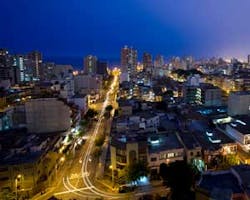IndigoVision helps reduce crime across Latin America
IndigoVision’s complete IP Video solution has been deployed across 17 cities in Latin America resulting in a significant decrease in local crime. The Serra beach area, near Vitoria in Brazil, has seen a dramatic drop in crime since the local authority implemented CCTV surveillance using IndigoVision’s technology. This is not an untypical situation as other cities in Brazil, Argentina, Peru, Chile and Mexico have found after installing IndigoVision systems.
Implementing CCTV surveillance over large urban areas is technically very demanding. Whether it is to monitor criminal activity or manage traffic, remote wide-area monitoring creates a challenging environment for CCTV systems – even more so with the high crime rates found in many Latin American cities.
What makes IndigoVision’s technology ideal for these applications and sets them apart from other digital CCTV solutions is its class-leading MPEG-4 and H.264 compression technology. Evidential-quality video can be transmitted across standard IP networks over large distances with minimal bandwidth requirement – an important issue for developing countries that often lack a proper communication infrastructure. This ensures latency is kept to a minimum, which allows PTZ cameras to be controlled smoothly from a distance, and wireless networks to be deployed easily to overcome the cabling problems associated with wide-area surveillance. CCTV operators in a number of the Latin American cities are using the fully synchronized high-quality two-way audio capability, which is transmitted alongside the video, to broadcast public announcements through camera mounted speakers. This capability can also be used to deploy video intercom help-points for use by the public.
"The success of the projects in Latin America has been replicated in many other city-wide IP-CCTV monitoring systems around the world," said Dr Oliver Vellacott, IndigoVision’s CEO. "Traditional analog CCTV technology is not suited to the large distances involved in wide-area surveillance such as city centers, road and rail networks, ports and airports. IP-based systems are also ideal for extending existing CCTV installations and creating a hybrid solution that utilizes existing investment and creates a foundation for migration to full IP Video in the future."
Analytics are becoming an increasingly important tool for CCTV operators to help monitor multiple cameras in urban environments. IndigoVision’s end-to-end solution implements real-time analytics at the camera as well as in ‘Control Center’, IndigoVision’s IP Video and alarm management software, for post event-analysis. Real time analytics such as motion detection or virtual tripwires automatically create a ‘Control Center’ alarm that can trigger a number of events such as displaying a camera salvo, panning a nearby camera or start recording. Automating the real time detection of incidents frees up valuable operator resource and having the same set of tools available to analyze large volumes of recorded footage dramatically reduces the time to locate critical events, enabling timely response to emergency situations.
IndigoVision’s distributed architecture allows any system component to be located at any point on the IP network, including Network Video Recorders (NVRs). IndigoVision’s NVRs record camera video directly from the network and can be distributed around the network to minimize bandwidth usage and create a fault tolerant solution by removing the single point of failure associated with analog/DVR systems. This means that the system is very flexible and scalable allowing existing cameras to be easily relocated or new cameras to be inexpensively added – an important benefit in the ever changing surveillance landscape of city centers. The distributed nature of the system also allows ‘Control Center’ workstations to be located anywhere on the network allowing different agencies and authorities access to live and recorded video.
Bandwidth requirement and NVR storage is further reduced by the implementation of a unique feature called Activity Controlled Framerate (ACF), which is deployed at the camera. ACF controls the amount of video that is transmitted on to the network from a specific camera. When the scene is inactive, the framerate is reduced, but as soon as any motion is detected in the scene the framerate is automatically set to maximum. This particular feature is very relevant for city-center monitoring as many areas at night are often quiet.
